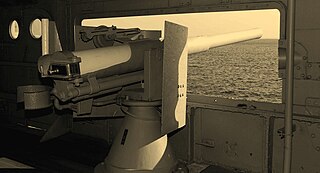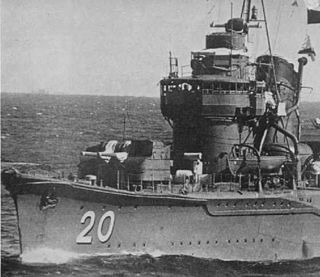
The L and M class was a class of sixteen destroyers which served in the British Royal Navy during World War II. The ships of the class were launched between 1939 and 1942.

The Yamato-class battleships were two battleships of the Imperial Japanese Navy (IJN), Yamato and Musashi, laid down leading up to World War II and completed as designed. A third hull laid down in 1940 was converted to an aircraft carrier, Shinano, during construction.

The Type 10 or 12 cm/45 10th Year Type naval gun was a Japanese 120 mm calibre dual purpose anti-aircraft and coastal defense gun used during the Second World War. It was derived from the 12 cm/45 3rd Year Type naval gun. The Type 10 number was designated for the year the gun was accepted, the 10th year of Emperor Taishō's reign, 1927 in the Gregorian calendar. It served as the secondary armament on a number of Japanese aircraft carriers and cruisers and as the main armament on smaller ships, in single or twin mountings.

The Type 96 25 mm gun was an automatic cannon used by the Imperial Japanese Navy during World War II. A locally-built variant of the French Hotchkiss 25 mm anti-aircraft gun, it was designed as a dual-purpose weapon for use against armored vehicles and aircraft, but was primarily used as an anti-aircraft gun in fixed mounts with one to three guns.

The 3"/50 caliber gun in United States naval gun terminology indicates the gun fired a projectile 3 inches (76 mm) in diameter, and the barrel was 50 calibers long. Different guns of this caliber were used by the U.S. Navy and U.S. Coast Guard from 1900 through to 1990 on a variety of combatant and transport ship classes.

The Hotchkiss 13.2 mm machine gun, also known as the Hotchkiss M1929 machine gun, was a heavy machine gun, primarily intended for anti-aircraft use, designed and manufactured by French arms manufacturer Hotchkiss et Cie from the late 1920s until World War II, which saw service with various nations' forces, including Italy and Japan where the gun was built under license.

The QF 12-pounder 12-cwt gun (Quick-Firing) was a common, versatile 3-inch (76.2 mm) calibre naval gun introduced in 1894 and used until the middle of the 20th century. It was produced by Armstrong Whitworth, Elswick and used on Royal Navy warships, exported to allied countries, and used for land service. In British service "12-pounder" was the rounded value of the projectile weight, and "12 cwt (hundredweight)" was the weight of the barrel and breech, to differentiate it from other "12-pounder" guns.

The Ordnance QF Hotchkiss 6 pounder gun Mk I and Mk II or QF 6 pounder 8 cwt were a family of long-lived light 57 mm naval guns introduced in 1885 to defend against new, small and fast vessels such as torpedo boats and later submarines. There were many variants produced, often under license which ranged in length from 40 to 58 calibers, but 40 caliber was the most common version.

A deck gun is a type of naval artillery mounted on the deck of a submarine. Most submarine deck guns were open, with or without a shield; however, a few larger submarines placed these guns in a turret.
The Imperial Japanese Navy Technical Department was the externally operating division of the Ministry of the Navy of Japan responsible for the administration of naval vessel construction. From 1923 onward, it took on the role of a research institution for the research and development of naval technologies and engineering. This included studying and investigating existing western naval technology, developing and overseeing Japan's domestic shipbuilding and arms industries, and training officers to become naval engineers and inspectors. The bureau was dismantled along with the naval ministry in November 1945 after Japan surrendered to the Allies at the end of World War II.

12 cm/45 3rd Year Type naval gun was a Japanese naval gun and coast defense gun used on destroyers, and torpedo boats of the Imperial Japanese Navy during World War II.

The BL 7.5-inch howitzer (naval) was a British anti-submarine mortar developed during World War I.

The 12.7 cm/50 Type 3 naval gun was a medium-caliber naval gun of the Imperial Japanese Navy used during World War II. It was the standard weapon for Japanese destroyers between 1928 and 1944. It has been credited as a true dual-purpose gun, but this was more a nominal capability than real, as its bag propellant and need for hand ramming required the gun to be loaded at elevation angles of 5–10°. This dropped its rate of fire to a relatively slow 5–10 rounds per minute, and its training speed of only 6° per second meant that it had a great deal of difficulty engaging enemy aircraft with any chance of success. After the end of World War II the gun remained in service on the two Japanese destroyers ceded to the Soviet Union and the Republic of China as war reparations.

The 8.8 cm SK L/45 was a German naval gun that was used in World War I and World War II on a variety of mounts.

The 8.8 cm SK C/35 was a German naval gun used in World War II.

The 14 cm/50 3rd Year Type naval gun was a Japanese low-angle weapon introduced during World War I.

The Type 41 3-inch (76 mm) naval gun otherwise known as the 8 cm/40 3rd Year Type naval gun was a Japanese dual-purpose gun introduced before World War I. Although designated as 8 cm (3.15 in), its shells were 76.2 mm (3 in) in diameter.

The 10.5 cm SK C/32 (SK - SchiffskanoneC - Construktionsjahr, was a widely used German naval gun on a variety of Kriegsmarine ships during World War II. Originally designed as a surface weapon, it was used in a number of other roles such as anti-aircraft and coastal defence; wet-mounts were developed for U-boats.

The 10 cm/65 Type 98 naval gun (六五口径九八式一〇糎高角砲), also known as the long 10cm high-angle gun (長10センチ高角砲), was a light caliber naval gun of the Imperial Japanese Navy used during World War II, employed on the aircraft carrier Taihō, the light cruiser Ōyodo, and Akizuki-class destroyers.

The 20 cm/12 short naval gun was a naval gun used by the Imperial Japanese Navy to defend merchant ships and land bases during World War II.



















